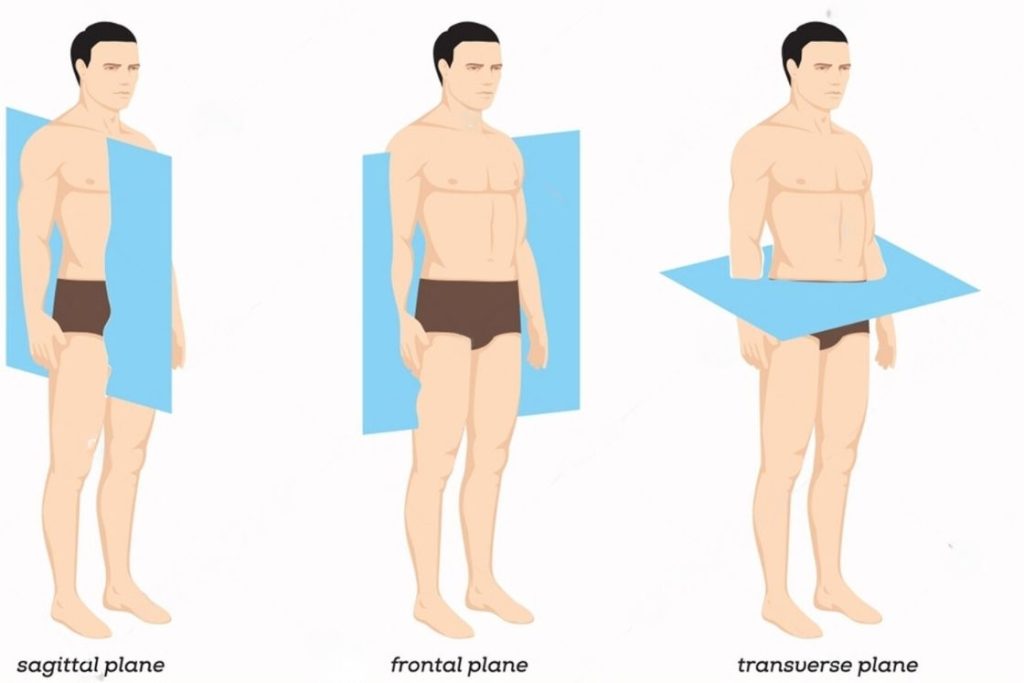
Yoga is more than just a series of stretches and poses—it’s a deep communion between mind, body, and spirit. To achieve this union, a yogi not only needs to be in tune with their inner self but also have a sound understanding of their physical body. One fundamental aspect often overlooked in the journey of yoga is the concept of anatomical planes. Just as a building requires a strong foundation, a yogi requires a firm grasp of how our body moves and aligns in space.
Understanding anatomical planes will not only improve your yoga practice but also help in preventing injuries and optimizing alignment. With the right knowledge, you can harness the full potential of each pose, ensuring that you’re not just moving but moving correctly. Let’s dissect the three primary anatomical planes and shed light on how they intersect with yoga. The next time you step on your mat, you won’t just be moving with the precision and awareness of an anatomy expert. Dive in, and let’s embark on this enlightening journey together.
Benefits of Understanding Anatomical Planes of Movement in Yoga
When you step onto your yoga mat, each pose invites you to align, stretch, and strengthen your body. But how do you ensure that each movement is aiding your practice, not hindering it? This is where understanding the anatomical planes is critical.
- Injury Prevention: By recognizing the natural pathways of movement, you can avoid straining muscles or putting undue pressure on joints. This knowledge serves as a shield, preventing potential yoga-related injuries.
- Optimized Alignment: With a grasp of anatomical planes, you can fine-tune your poses. Whether it’s a simple mountain pose or a more complex triangle pose, your alignment will be spot-on, ensuring maximum benefit.
- Deeper Stretches: Anatomical awareness allows you to understand your body’s limits and potential. This means you can push yourself just enough to achieve deeper stretches without overextending.
- Enhanced Mind-Body Connection: As you move with awareness of anatomical planes, you become more attuned to your body’s subtle signals. This fosters a stronger mind-body connection, amplifying the meditative benefits of yoga.
- Better Posture Off the Mat: This understanding isn’t limited to your yoga sessions. Being aware of how your body aligns and moves translates to better posture in daily activities, reducing the risk of strain and discomfort.
In essence, understanding anatomical planes elevates your yoga practice, ensuring safety, precision, and enhanced benefits.
What is an Anatomical Plane of Movement?
At the heart of every movement lies a map that seamlessly guides our bodies, whether we’re twisting, bending, or stretching. In anatomy, this map is defined by the planes of motion. But what exactly is an anatomical plane?
An anatomical plane is a hypothetical flat surface that slices through the body, dividing it into distinct sections. It provides a standardized point of reference to describe the location and direction of body parts relative to each other. This knowledge isn’t just reserved for anatomists or surgeons. In disciplines like yoga, understanding these planes is crucial as it aids in executing movements with precision.
Imagine directing someone without understanding the concepts of left, right, forward, or backward. It would be nearly impossible! Similarly, anatomical planes serve as a compass for our body, ensuring we move correctly, efficiently, and safely. They are fundamental in dictating how and in which direction a particular body part or segment can move concerning another.
What are the 3 Anatomical Planes of Body Movement?
Let’s break down the three primary invisible lines along which our body moves: the anatomical planes of movement:
1. Sagittal Plane
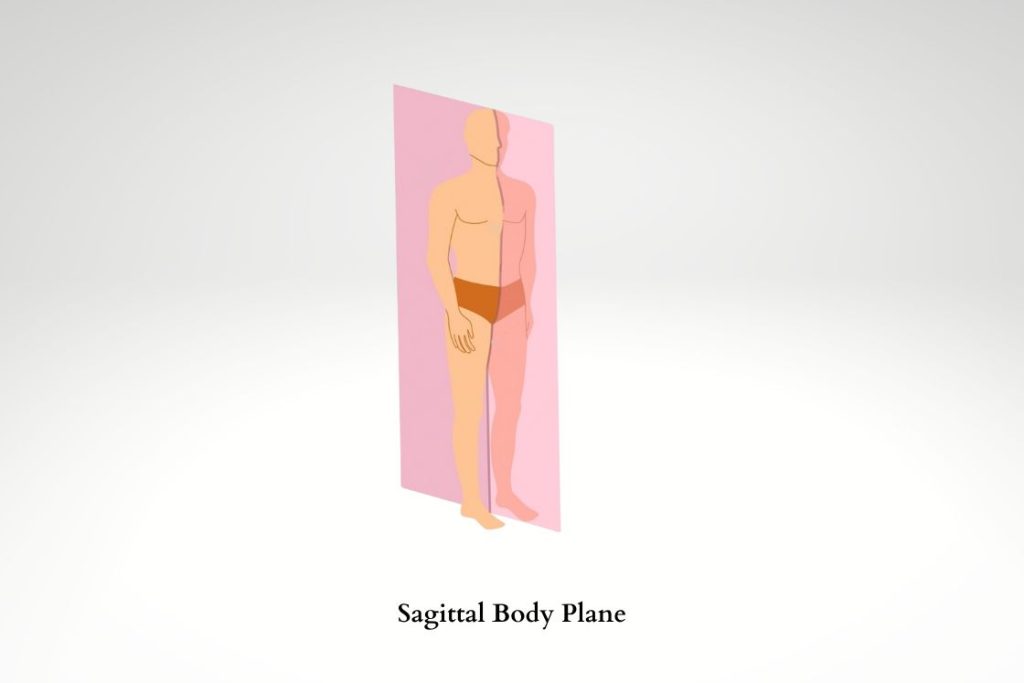
This plane divides the body into left and right halves. Movements in the sagittal plane include flexion (bending) and extension (straightening). Think of the forward bend in yoga or standing up straight after a forward fold.
2. Frontal (Coronal) Plane
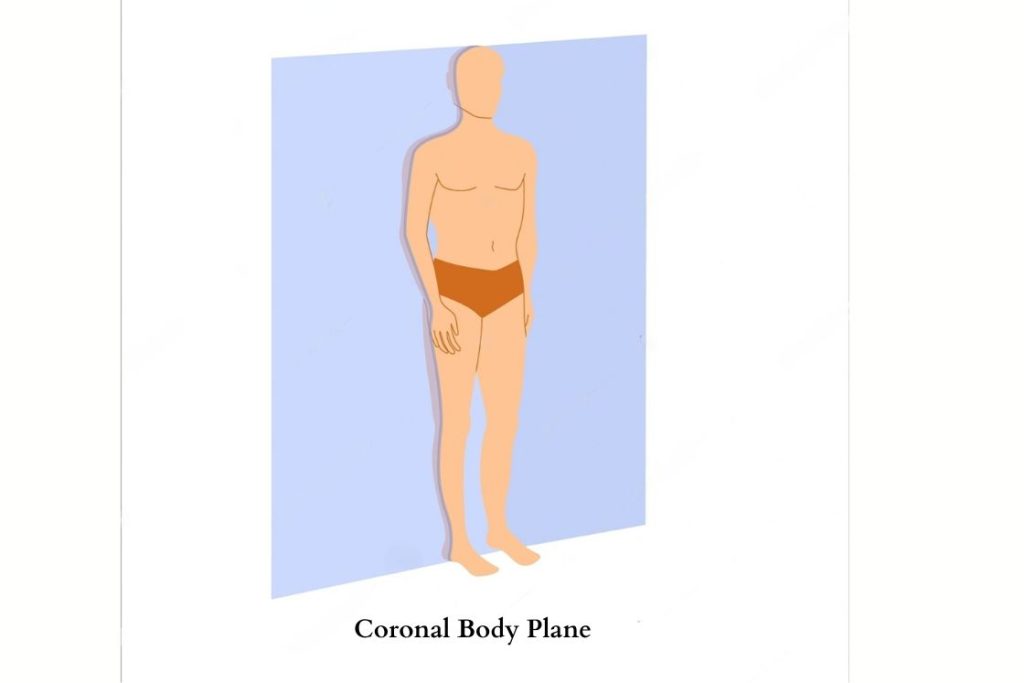
The frontal divides splits the body into front (anterior) and back (posterior) portions. Movements here encompass abduction (moving limbs away from the body’s midline) and adduction (bringing them back towards the midline). Side stretches in yoga, where you extend your arm over the head to one side, happen along this plane.
3. Transverse (Horizontal) Plane
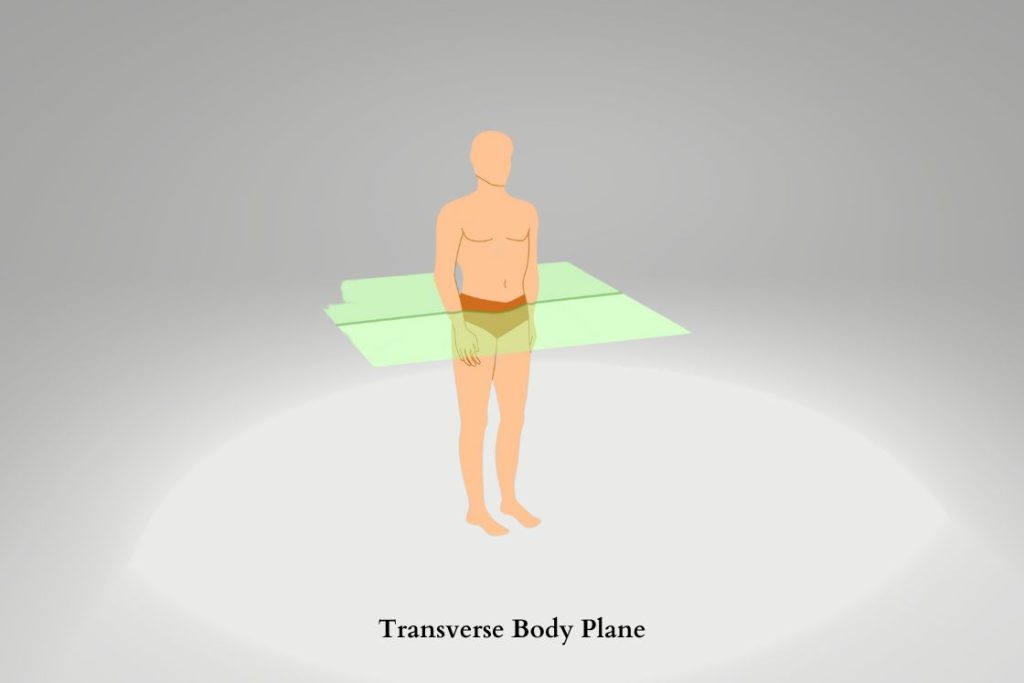
This plane divides the body into upper and lower sections. Rotational movements occur here, like when you twist your torso from side to side in a seated spinal twist.
By identifying and understanding these planes, you can ensure that each pose aligns with the natural directions of body movement.
Movements and Yoga Poses Along the Sagittal Plane
Following are the movements and the yoga poses that align with the Sagittal Plane:
Movements in the Sagittal Plane:
- Flexion: This involves decreasing the angle between two body parts. In terms of limbs, it’s bending; for the spine, it’s forward bending.
- Extension: The opposite of flexion, extension involves increasing the angle. Straightening a bent arm or standing up from a forward bend are examples.
Yoga Poses in the Sagittal Plane:
- Paschimottanasana (Seated Forward Bend): In this pose, the spine flexes forward, a classic sagittal plane movement.
- Urdhva Mukha Svanasana (Upward Facing Dog): This pose extends the spine, opening the chest and tilting the head skyward.
- Balasana (Child’s Pose): Curling into this restorative pose involves flexion of the hips, knees, and spine.
- Tadasana (Mountain Pose): Standing tall and erect with a neutral spine, this foundational pose is about maintaining an extended, upright position.
- Ustrasana (Camel Pose): As you arch your back, the spine undergoes extension, creating a backward bend.
Movements and Yoga Poses Along the Frontal (Coronal) Plane
Here’s a concise look at these movements and the yoga poses that embody the Frontal plane of motion.
Movements in the Frontal Plane:
- Abduction: This refers to a movement that takes a limb away from the body’s midline. Lifting your arms or legs sideways demonstrates abduction.
- Adduction: The opposite of abduction is adduction. This movement brings the limb back towards the body’s center. Lowering a raised arm or leg to its initial position is a clear example.
Yoga Poses in the Frontal Plane:
- Utthita Parsvakonasana (Extended Side Angle Pose): The stretching of the arm over the head and extending the side body in this pose showcases abduction.
- Prasarita Padottanasana (Wide-legged Forward Bend): With the legs spread wide, this pose engages the hips in abduction while the upper body folds forward.
- Trikonasana (Triangle Pose): As you hinge sideways and reach one arm towards the sky and the other down, this pose involves the abduction of the arms in different directions.
- Ananda Balasana (Happy Baby Pose): Lying on your back and holding the outer edges of your feet while keeping the knees apart demonstrates hip abduction.
- Utkata Konasana (Goddess Pose): This deep squat with knees pointing outwards aligns with the frontal plane as the thighs move away from the midline in abduction.
Movements and Yoga Poses Along the Transverse (Horizontal) Plane
Let’s explore the movements and yoga poses that correspond with the Transverse Plane of motion.
Movements in the Transverse Plane:
- Rotation: This movement revolves a body part around its axis. In terms of the torso, it’s turning or twisting; for limbs, it’s an inward or outward rotational movement.
- Horizontal Adduction & Abduction: It’s the movement of the limbs towards (adduction) or away (abduction) from the midline, but in a horizontal manner, like spreading your arms sideways while lying face up.
Yoga Poses in the Transverse Plane:
- Ardha Matsyendrasana (Half Lord of the Fishes Pose): Seated and twisting the spine, this pose exemplifies rotation in the transverse plane.
- Parivrtta Trikonasana (Revolved Triangle Pose): As you rotate the torso while keeping the legs firmly grounded, this pose combines stability with transverse rotation.
- Parivrtta Utkatasana (Revolved Chair Pose): This pose involves a deep squat coupled with a twist, rotating the upper body to one side.
- Supta Baddha Konasana (Reclining Bound Angle Pose): Lying on the back with soles of the feet together and knees spread wide, this pose involves horizontal abduction of the thighs.
- Bharadvajasana (Bharadvaja’s Twist): A seated spinal twist, this pose engages the spine in a rotational movement around its axis.
Important Yoga Movements and Their Anatomical Plane
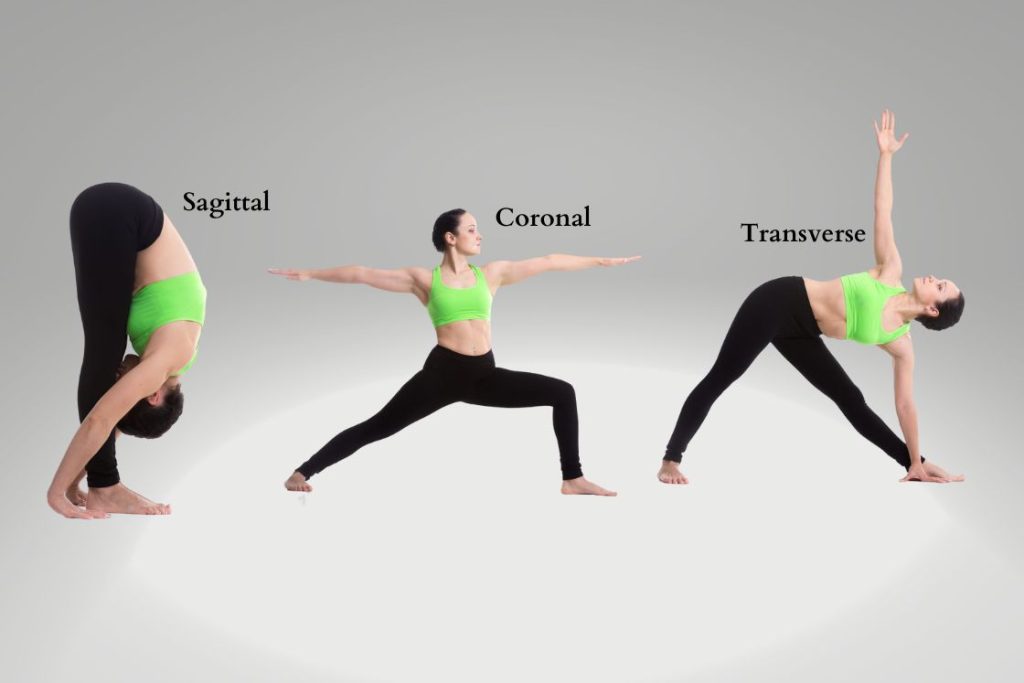
In yoga, our body performs a series of specific movements, each aligned with a particular anatomical plane. Recognizing this alignment enhances our practice, ensuring better posture, safety, and deepened awareness. Here’s a breakdown:
Sagittal Plane (divides body into left and right):
- Head Tilt Up & Down: Movement of the head to look upwards or downwards, common in Urdhva Mukha Svanasana (Upward Facing Dog) and Adho Mukha Svanasana (Downward Facing Dog).
- Bending Forward & Arching Back: As seen in Uttanasana (Standing Forward Bend) and Bhujangasana (Cobra Pose).
- Knee Bending: As one does while transitioning into Utkatasana (Chair Pose).
- Dorsiflexion & Plantarflexion of Feet: Lifting the front of the foot or pressing down through the heels, respectively.
- Pelvic Tilts: Anterior and posterior tilts often used in foundational practices for alignment.
- Toe Pointing & Flexing: Movement of the feet in Viparita Karani (Legs-Up-The-Wall Pose) or Tadasana (Mountain Pose).
- Spinal Flexions: As you round the back in Marjariasana (Cat Pose) during the exhale.
- Leg Raises: Elevation of the leg forward, as in Uttitha Hasta Padangusthasana (Extended Hand-to-Big-Toe Pose).
Frontal/Coronal Plane (divides body into front and back):
- Side Bends of the Spine: Evident in Parighasana (Gate Pose) or Parsva Upavistha Konasana (Side Seated Wide Angle Pose).
- Head Tilt Side to Side: Lateral movement of the neck, often incorporated in warm-ups.
- Rolling Shoulders Back or Forward: Shoulder blade movements, commonly seen in postural adjustments.
- Hip Abduction: Legs moving apart in Upavistha Konasana (Seated Wide Angle Pose).
- Ankle Eversion & Inversion: Tilting the soles of the feet outward or inward.
- Elbow Abduction: Moving elbows out to the sides as in cactus arms.
Transverse/Horizontal Plane (divides body into upper and lower):
- Shoulder & Hip Rotation: Twisting or pivoting motions, often emphasized in postures like Parivrtta Trikonasana (Revolved Triangle Pose).
- Head Rotation: Turning the head from side to side, commonly practiced in seated postures for neck relaxation.
- Wrist Pronation & Supination: Rotational movement of the forearm, especially when transitioning between pronated and supinated hand positions on the mat.
- Spinal Twists: Present in poses like Parivrtta Parsvakonasana (Revolved Side Angle Pose) or Supta Matsyendrasana (Supine Spinal Twist).
- Hip External & Internal Rotation: Movements emphasized in postures like Gomukhasana (Cow Face Pose) or Agnistambhasana (Fire Log Pose).
- Forearm Pronation & Supination: Transitioning from palms-up to palms-down positions in seated postures or arm balances.
- Shoulder Horizontal Abduction & Adduction: Moving arms toward or away from the body’s midline in Tadasana (Mountain Pose) with varied arm positions.
- Knee Rotations: Gentle rotations sometimes practiced in Pawanmuktasana (Wind-Relieving Pose) sequences for joint health.
Common Mistakes in Yoga and How Anatomical Knowledge Can Help
Yoga, while appearing fluid and graceful, requires a precise understanding of body movement. Even seasoned yogis can occasionally falter in their poses. Let’s highlight some common mistakes made in yoga and discover how a grasp on anatomical planes can rectify them.
Incorrect Spinal Alignment in Forward Bends
A frequent error is rounding the back in poses like Uttanasana (Standing Forward Bend). Recognizing the sagittal plane helps us align the spine correctly, ensuring a straight back as we hinge from the hips.
Misaligned Hips in Warrior Poses
In poses like Virabhadrasana II (Warrior II), uneven hips can lead to strain. Knowledge of the frontal plane can assist in leveling the pelvis, leading to a more stable and comfortable stance.
Over-Twisting in Spinal Rotations
Over-enthusiasm in poses like Parivrtta Trikonasana (Revolved Triangle Pose) can cause excessive strain. An understanding of the transverse plane aids in gauging the right amount of twist, for the safety of the spine.
Improper Foot Position in Standing Poses
The alignment of feet in postures like Tadasana (Mountain Pose) can sometimes be overlooked. Recognizing the sagittal and frontal planes helps ensure feet are grounded with weight distributed evenly.
Shoulder Misalignment in Downward Dog
In Adho Mukha Svanasana (Downward Facing Dog), elevated shoulders can strain the neck. With knowledge of all three planes, yogis can ensure proper shoulder alignment, creating space around the neck and ears.
Misplaced Knee in Lunges
In poses like Anjaneyasana (Low Lunge), the knee might surpass the ankle, leading to potential joint strain. Awareness of the sagittal plane ensures that the knee aligns directly over the ankle, offering better support.
Uneven Weight Distribution in Balancing Poses
In postures such as Vrksasana (Tree Pose), practitioners might lean to one side. Understanding the frontal plane can help evenly distribute weight, stabilizing the pose.
Hyperextending the Elbows in Plank Pose
In Plank, there’s a tendency to lock or hyperextend the elbows. Recognizing the importance of the sagittal plane can encourage a micro-bend in the elbows, reducing the risk of injury.
Flaring Ribs in Backbends
In poses like Urdhva Mukha Svanasana (Upward Facing Dog), the ribs might flare out. By acknowledging the frontal and sagittal planes, yogis can focus on drawing the ribs in, promoting better core engagement.
Shallow Breathing in Twists
In poses like Marichyasana (Marichi’s Pose), deep breathing can be compromised due to a tight twist. Knowledge of the transverse plane can guide the extent of rotation to a point till where the breathing remains unhindered.
How Understanding Anatomical Planes Aids in Coordinating Breath with Movement

Breath is the essence of yoga. It not only nurtures our body but also amplifies the efficacy of each pose. Integrating breath with movement, or pranayama, is a core aspect of yoga, and an understanding of anatomy can refine this union. Here’s how:
Breathing with Sagittal Plane Movements
In poses like Uttanasana (Standing Forward Bend) or Bhujangasana (Cobra Pose), where the body moves forward and backward, a clear comprehension of spinal anatomy helps. With each inhalation, the spine can extend or arch, making space. With each exhalation, practitioners can deepen into the flexion or bend, ensuring smooth transitions without strain.
Breathing with Frontal Plane Movements
Consider poses like Trikonasana (Triangle Pose) where the body moves sideways. Knowledge of the ribs and intercostal muscles – which lie between the ribs – aids in maximizing lung expansion. Breathing in sync with this plane’s movements ensures that one side of the chest expands fully without compression on the other side.
Breathing with Transverse Plane Movements
For rotational poses like Parivrtta Trikonasana (Revolved Triangle Pose), understanding the anatomy of the torso is crucial. As one twists, the inhalation can create space between vertebrae, and the exhalation can facilitate a deeper twist. This harmonizes the breath with the rotation, preventing abrupt or forced movements.
Integrated Movement across Planes
In sequences like Surya Namaskar (Sun Salutations), where movements span multiple planes, anatomical knowledge helps in fluid breath coordination. Understanding how the diaphragm and chest muscles work together can guide breath regulation, ensuring that inhalations and exhalations are neither too shallow nor too forceful.
Visualizing Anatomical Planes to Enhance Body Awareness During Meditation and Relaxation

Meditation and relaxation in yoga are not just about calming the mind; they’re also avenues to cultivate a deeper connection with our bodies. Incorporating the visualization of anatomical planes can enrich this connection, developing body awareness. Here’s how:
Grounding through the Sagittal Plane
Visualizing the sagittal plane, which runs from front to back, can aid in aligning the spine, head, and pelvis. By mentally tracing this plane, practitioners can ensure they’re seated or lying down with optimal posture, leading to more comfortable and effective meditation sessions.
Balancing with the Frontal Plane
By picturing the frontal plane, which divides the body into front and back, individuals can check for any uneven weight distribution. This visualization helps in aligning shoulders, hips, and even facial muscles, promoting relaxation and reducing muscle tension.
Centering via the Transverse Plane
The transverse plane, which bisects the body into upper and lower halves, is vital for recognizing and maintaining our center of gravity. By visualizing this plane, practitioners can ensure they are grounded, whether sitting cross-legged or lying in Savasana (Corpse Pose).
Deepening Body Awareness
Consistent visualization of these planes trains the mind to automatically recognize misalignments or tension. Over time, this practice can lead to heightened body awareness, not just during meditation but throughout daily activities.
Consciously Putting the Anatomical Planes into Practice
Incorporating the principles of anatomical planes in yoga transcends mere theoretical knowledge; it’s about consciously integrating these principles into every movement and pose. Start with the sagittal plane, focusing on forward and backward movements. For instance, as you transition into Uttanasana or Tadasana, be mindful of the alignment from your head down to your feet. Moving to the frontal plane, when executing poses like Virabhadrasana II or Trikonasana, concentrate on the lateral alignment, ensuring your body is neither leaning forward nor backward.
Finally, while exploring the transverse plane in twists and rotations, remember to respect the natural range of your spine and torso, rotating with awareness rather than force. Additionally, during meditation or relaxation, visualize these planes to deepen body awareness and enhance alignment. Gradually, with consistent attention to these planes, your practice becomes more intentional, safe, and transformative. By consciously implementing anatomical planes, not only does your physical yoga practice evolve, but you also cultivate a heightened mindfulness that permeates other facets of life.





Namaste Anubhav,
Thank you for writing this article and helping the practitioners, especially the teachers of yoga to practice and guide in safe and accessible manner.
I would like to incorporate your article, or part of it in my yoga training manual. Our school offers both the foundational and advanced teacher trainings, 200 and 300 hours.